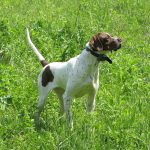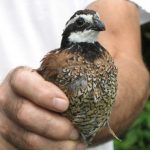POINTING DOG POINTERS: In the Beginning . . .
By Bob and Jody Iler
You’ve decided!
You’ve checked out the many pointing dog breeds and determined which one is right for you. Now it’s the happy day when – after doing your research and finding a reputable breeder – you are finally bringing that new pup home! If you’re new to the world of pointing dogs, your next big question will be: Should I raise my pointing dog pup in a different manner than I would another breed of dog?
Our answer is yes – in certain areas of your pup’s development you’ll do things differently, and no – for the usual puppy issues like housebreaking, diet, inoculations, and basic socialization, you’ll do what you’ve done in the past for other pups you’ve had. But in case this is your very first pup ever, let’s review the basics of having a new puppy.
Puppy Care Basics
Like the arrival of a baby, things will now be different in your home and routine! Your new pointing dog pup will need the secure comfort of your love, presence, and guidance in her new and unfamiliar environment. She’ll need a cozy crate to call her own – to sleep and nap in, and to stay safe in for the periods of time when you are busy and can’t watch her. The crate can be plastic with a metal gate or wire mesh, and it should be large enough for your pup to stand and turn around comfortably in when fully grown. We prefer wire crates but plastic crates work well too, although there could be an issue with ventilation on warm days.
The crate will be your invaluable aid to successful housebreaking. Crate training made easy comes with one cardinal rule: Take your pup out to potty before you put her in the crate, and take your pup out to potty immediately after you take her out of the crate. No exceptions. And stay outside until she does her duty. Of course, during the short, supervised times that you let pup loose in the house at first, you must be on the watch for circling and sniffing, especially after play and exertion. Young pups drink and eat often and, as a result, need to empty out often too. Remember to take your pup out specifically for potty, not for exercise and play at the same time. She’ll learn faster if the two are kept separate early on. The time and effort you devote to instilling a regular housebreaking schedule in the first few weeks will ensure success.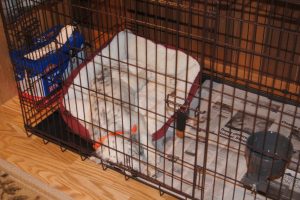
Though the crate is also the “timeout” and nap place, it should never be used as a punishment for your pup, nor should pup be kept in the crate for excessive periods of time — on average, no longer than 3-4 hours. Very young pups will need papers or a potty pad on one side of the crate at first. Be wary of towels, blankets, and dog beds in the crate during the early months. If your pup likes to chew, don’t leave these items in the crate, especially when you’re not home or during the night. Give your pup a safe chew toy like a Nylabone while in the crate. For safety, don’t leave a collar on your pup while in a wire crate.
As your pup grows, she should have plenty of supervised time to play in the house – preferably in a gated area where she can’t get into trouble or chew up the good recliner. This will help her to learn house rules, and what she can and can’t do as a member of the family. You’ll establish regular feeding times for her and allow her to eat undisturbed in her special spot. Very young pups will eat a quality puppy food three times a day. By approximately three to four months old, your pup should eat twice a day until at least a year old. Take care not to over exercise your pup after feeding.
Get your young pup accustomed to wearing a flat collar, and use a long (12-15 ft.) cotton web lead to take her outside for exercise and potty. By doing this, you’ll establish control over your pup as she grows. When you call her name and say come, you’ll have a way to gently encourage her to obey you by using your light long line. And believe us, the day will come when your pup will ignore your come command and you’ll be glad you’ve made this a regular practice. You’ll also get her used to walking with you on a shorter six-foot cotton web or leather lead.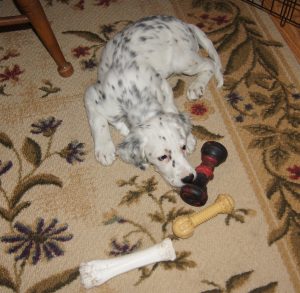
Get your pup accustomed to short rides in your vehicle. Keep the rides calm and brief at first, and don’t do this after a meal. It’s better to use your crate in the vehicle initially, as many pups can get carsick. Be matter of fact and fun about these short outings and don’t push any unpleasant issues. Let time and familiarity help and encourage her. Eventually, rides can lead to fun excursions, whetting her enthusiasm for those future hunting trips.
In the same easygoing manner, introduce your pup to other people and situations on a case by case basis as she grows, depending on pup’s age and temperament. Never force unpleasant scenarios and take the time to watch your pup’s reaction to all things new, and act/adjust accordingly.
Raising a Pointing Pup
‘Okay, I’ve got this,’ you say! So – what exactly should I do that is different with my pointing dog pup as she develops?
Pointing dogs are bred to hunt! They enjoy an active, working lifestyle and have an abundance of energy. It’s just not in their nature to spend too much time cooped up. Your pup will need plenty of opportunities to expend that energy. Therefore, since you’ve committed to a pointing dog, you’ve also committed to exercising her! This means plenty of playtime for the young pup, and lots of walks and runs outdoors as she grows. These dogs need exercise or they’ll start bouncing off the walls and possibly getting into trouble. A tired puppy is a happy puppy. A word of caution: as your pup grows, you should be mindful of over-exercising while her bones are growing – no agility jumping or long-distance jogging until she’s fully grown.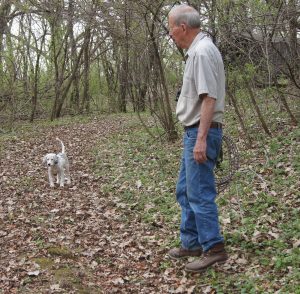
For her future role as your hunting partner, it’s important to have your pup experience the world of nature. Introduce her to fields and woods, starting with age-appropriate, lower cut fields and fairly open, easy-to-navigate woods. Find places with shallow creeks that she can play in and get used to water. Encourage her to become independent in the field and not to walk at your side. You want her to be brave and curious, maybe even headstrong! Everything should be fun, positive, and safe, with experiences that build on one another.
Our philosophy on early obedience training for our pointing dog pups is simple. We don’t do a lot of obedience training at this stage! We teach our pup to come when called (using that long line above). We teach our pup to walk on a six-foot lead with us. We teach her manners in the house, yard, and neighborhood. And for now, that’s where we end it. We don’t teach our pup to heel, to sit, to lie down, or to stay. And a word here about the electronic collar; if you have one, keep it in the case. We feel that the e-collar has no place in the life of a young pup.
If you have access to some quail, you can gently introduce your pup to some hobbled quail on a field excursion or two. If your pup is interested in the quail, you can unhobble the quail and let her chase it. Don’t entertain any thoughts about shooting around your pup at this point, and don’t take your young pup hunting with an older dog to “learn the ropes” either.
It’s important to be mindful of positive noise experiences with your pup in these early months. Don’t bang pots, slam doors, or go near a shooting range to “desensitize” your pup. Our pups never begin gun development until they have first learned to love and chase birds, and this won’t happen until formal gun dog training begins at about six months of age.
This is a time when pups should just be pups – like toddlers – to run and play and have fun while learning all about the world. This is a crucial time when your pup will bond with you as the most important person in her world. This is a time when you are laying the groundwork for happy years afield with your future hunting partner. Be patient. Let her be a pup.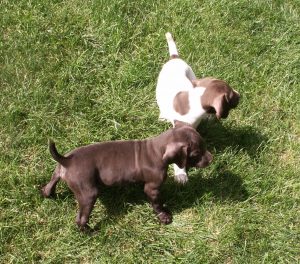
Pointing Dog Pointers features monthly training tips by Bob and Jody Iler, who own Green Valley Kennels in Dubuque, Iowa. Bob and Jody have trained pointing dogs for over 35 years and have written many articles for Pointing Dog Journal.




